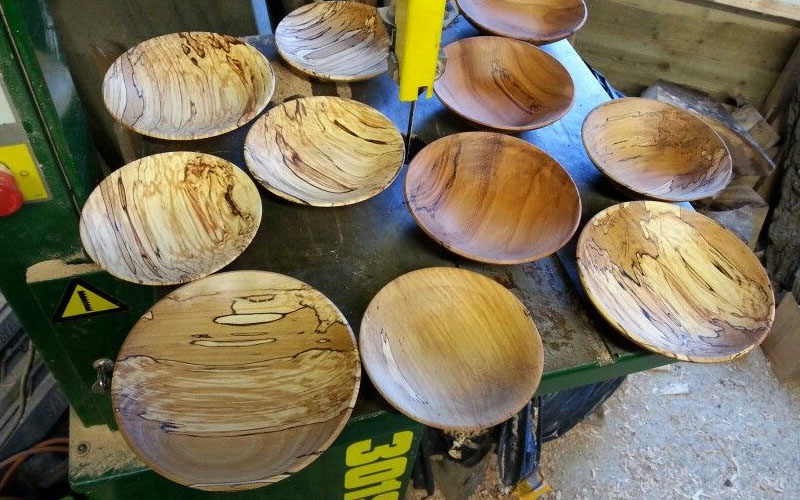Mulberries are deciduous trees native to the warm temperate and subtropical regions of the world.
Mulberry wood offers timber for fire, fruity smoke for the senses, and fruits for the tongue. Yes! When you have it, you have an unsung hero beside you.
Mulberry wood is also known for its good natural luster and rated as the most durable wood that comes with insect resistance and weathering properties.
How it happens because mulberry has no odor for the insects but a sweet and tarty aroma for humans. In use, it is used to make small pens to bigger decorative pieces.
Need to know more?
Here is a detailed guide on all the things you need to know about mulberry wood trees.
Table of Contents
Mulberry Wood:
All woods burn and so does mulberry but it is often well-thought-out as the most considerable firewood. It burns well when compared to other woods like acacia.
It is excellent to produce long-lasting heat and coals because it burns slowly and steadily, providing warmth for a long time.
Perfect for campfires and cooking but recommended to use in outdoor fireplaces because mulberry produces very harsh sparks. You can even use a bellow tool to spark them up quickly.
Mulberry Tree Types:
If we go on a vast scale, we find two major varieties of mulberry wood. One is a mulberry tree with fruits while the other one, a fruitless mulberry tree.
However, when it comes to using mulberry wood and the importance of this miraculous wood, we find three fruitless mulberry wood varieties, given as follows:
Here are some types of wood you can get from mulberry trees:
1. White Mulberry:

- Scientific name: Morus alba
- Common name: white mulberry, common mulberry, silkworm mulberry
- Native to: China
- Edible Fruits: Yes, produces variable color fruits (white, pink, black, and red)
- Flowers: Yes
- Age: Short-lived tree (60 to 90 years)
- Tree Size: 33 – 66 ft tall
- BTU: High
- Common Use: Firewood, baskets, pens, pencil making, silkworm food, preparing tea
White mulberry trees are very easy to grow and require minimal care. It takes minimal time to grow.
It can thrive well even in dry soils and can sprout well even while receiving only 4 hours of sunlight, making it ideal for plants-covered spaces and yards.
Despite being native to China, Morus alba is cultivated widely and easily obtainable in United States, Mexico, Australia, Kyrgyzstan, Argentina, Turkey, Pakistan, Iran, India, etc.
Morus alba is called white or silkworm mulberry because of the white floral buds and because the fruits and leaves are widely given to silkworms as their food.
2. Black Mulberry:

- Scientific name: Morus nigra
- Common name: Black Mulberry, Blackberry (not the Rubus family berries)
- Native to: Southwestern Asia, Iberian Peninsula
- Edible Fruits: Yes, Dark purple, blackish
- Flowers: Yes
- Age: Hundreds of years
- Tree Size: 39 – 49 ft
- BTU: high
- Common Use: edible fruits,
Black mulberry or Morus nigra is the longest-living variety of mulberry fruit. However, it also takes years and years to get mature.
The tree is mainly cultivated for its ripe and tasty fruits in Asia, Europe, America, and other southern parts of the world.
Mulberry trees grow so tall and offer excellent shade to lean in and fruits, the excellent options to enjoy summers.
3. Red Mulberry:

- Scientific name: Morus rubra
- Common name: Red mulberry
- Native to: eastern America, central North America, Florida, Minnesota
- Edible Fruits: Yes, plate green ripening to dark purple
- Flowers: green leaves, turn yellow in autumn
- Age: up to 125 years
- Tree Size: 35–50 ft tall but can go up to 65 ft in rare cases
- BTU: High
- Common Use: wines, formation of jams, jellies, and marmalades, firewood, furniture, fences, woodturning objects
Red mulberry once again produces ripe fruits that are used in the formation of jams, jellies, juices, and wines.
However, its hardwood is used to make furniture, bowls, baskets, and fencing objects for gardens and balconies.
The wood is also used to make pool cabanas and backyard pavilion designs.
4. Korean Mulberry:
- Scientific name: Morus latifolia
- Common name: Korean mulberry
- Native to: China, Japan, and Korea
- Edible Fruits: Yes
- Flowers: Yes
- Age: unknown
- Tree Size: 24 ft and 4 inches
- BTU: High
- Common Use: edible fruits, and tea, making paper
Korean mulberry or Kokuso trees also produce delicious dark fruits that can be as long as 2 inches. This is the mulberry from cold areas.
Apart from this, Korean mulberry wood produces excellent timber for fire and also used in the formation of papers.
5. Himalayan Mulberry:
- Scientific name: Morus Serrata
- Common name: Himalayan mulberry
- Native to: mountains of Himalaya, and china
- Edible Fruits: Yes
- Flowers: Yes
- Age: 100 to 250 years
- Tree Size: 15 m tall
- BTU: High
- Common Use: Edible fruits
You can call Himalayan a dwarf variety of mulberry trees because It can grow up to 15 meters but produces sweet and juicy fruits that grow in clusters.
Some researchers don’t consider Himalayan mulberry an independent species but sub-species of white or black mulberry. However, the species grows at a high elevation and makes a perfect food for tourists and mountaineers.
Mulberry Tree Identification:
As there are different types of mulberry trees available, hence the wood texture and appearance vary as well.
Here are the things you need to know about mulberry wood identification.
1. Mulberry Wood Color Appearance:

The appearance of the wood varies from one type of tree to another. Red mulberry is mainly used in furnishing and to make home-related items.
The appearance of red mulberry is golden brown at the start and with the passage of time turns into darker brown to medium reddish shade. While the outer layer of sapwood can be pale.
On the other hand, you can identify black mulberry by its uniformly hairy lower leaf surface while a white mulberry tree with its rapid release of pollen.
They don’t need a lot of water or fertilizers to grow. A person even claimed in this Reddit thread that it will grow like a weed. Meaning? No special care needed.
2. Mulberry Wood Grains Appearance
The appearance of mulberry wood is naturally glossy and there is uniform grain texture available on the raw wood logs.
It has a straight uniform grain texture appearance.
You may also find little cracks on the surface of mature mulberry trees. These cracks are common to appear on the surface of the wood as it gets old.
3. Mulberry Wood Odor:
As mulberry tree bears ripe berry fruits that have a very pleasant fragrance, hence the wood also has a pleasant smell.
When dry, the wood doesn’t have any characteristic odor but when burned, mulberry wood smoke is not sour or harsh in smell.
4. Durability:
Due to its smaller size and scattered distribution mulberry isn’t used as lumbers like for furniture making or flooring. However, it doesn’t mean that the wood is not durable.
Mulberry wood is extremely durable, insect-proof, and weather resistant.
Besides, mulberry wood is insect resistant and weathering. This excellent durability and scarce distribution make mulberry the most expensive wood in the world.
5. Sap Content/ Resin:
The sap content or resin in mulberry wood is as high as it will be in firewood. You might see sometimes the resin coming out of the trunk of your mulberry tree.
Well, a mulberry tree bleeds more due to infection. This resin, sap, or juice that is also called latex can be mildly toxic.
6. Mulberry Wood for Woodturning:

Large types of mulberry trees produce larger boards that can be used in woodturning and furniture making.
Though it might go a little expensive, drop-leaf tables, chairs and benches are examples of the use of mulberry for woodworking.
It is also used to make bowls and woodturning goods just like Olive wood.
However, the wood is not very easy to work with. You need to be very professional and expert to work with it because sometimes a simple nail might tear the wood board into two.
Now, here you go with Mulberry Wood Uses:
Mulberry Wood Uses:
The best and most common use, when it comes to this tree, is that people grow mulberry for its ripe and edible fruit.
On the other hand, when it comes to mulberry wood, the uses are as follows:
1. Excellent carbon sinks
Trees are the source of oxygen generation in the environment and Mulberry trees are no different. In fact, they are superb. According to studies, a 1m tall Mulberry tree has the ability to absorb 4,126kg of carbon dioxide and release 3,064kg of oxygen in a year.
Imagine having groups of them planted around your house and society. The same study showed that they’re great at absorbing air pollutants like hydrogen and sulfur dioxide as well.
2. Furniture
Mulberry’s wood durability, rot resistance and ease of workability make it a suitable candidate for constructing furniture items like benches and chairs. In Japan, this wood, especially the ancient Shumakuwa variety, has been used to make tea-ceremony rooms and cabinetry for centuries.
They have a straight grain and an aesthetic golden brown hue (database), ensuring each piece of furniture is one to eye for.
3. Treating Alzheimer’s disease
Mulberry leaves are used to make juice with a high concentration of proteins, vitamins A, B, C, calcium, magnesium and deoxy nojirimycin. All these work together to act as an effective treatment for Alzheimer’s disease.
Other than that, they are used for the following purposes:
- Fence posts for balcony and gardens
- White mulberry is mainly used as a silkworm food source.
- To produce sheets and pages
- Pencil, pens, and penitentiary
Before ending, here you go with the FAQs, our readers send to us:
1. Is Mulberry hard or soft wood?
Although mulberry wood is soft, it is considered hardwood because the tall mulberry trees offer wood that can produce huge boards to make furniture.
2. Is Mulberry wood rot-resistant?
Not all mulberry woods are rot-resistant and used commercially for furniture making. However, red mulberry is extremely rot-resistant and used for outdoor molding and applications. This wood contains high levels of natural extractives like tannins, which are toxic to fungi and insects.
4. Why are mulberry trees illegal?
Not all mulberry trees are illegal but white mulberries due to excessive spread of pollen were declared illegal to grow in Arizona and some other parts of the USA.
5. Is Mulberry a good firewood?
Mulberry is incredible firewood with BTU 25.8 that produces admirably high heat. It is amongst the top heating firewood.
The best thing about mulberry wood is it burns slowly and gives warmth for a long time. Besides, mulberry wood makes an excellent source of coals.
6. How to burn Mulberry wood?
Mulberry wood is great at burning and doesn’t produce a lot of smoke. However, before burning it, make sure the mulberry wood is completely dry. Otherwise, it may smoke more than it should.
However, make sure the mulberry wood is burned in the outside firewood as it sparks too much and can burn or fire.
Bottom Line:
So, we have mentioned almost all the possible things you can do by using mulberry wood. Do you have any more ideas? Let us know in the comments below.
Reference:
https://gardenoracle.com/images/morus.html#:~:text=Lifespan%3A%20500%20to%201000%20years,for%20Morus%20rubra%3A%20Red%20Mulberry.
http://www.efloras.org/florataxon.aspx?flora_id=2&taxon_id=242333084

